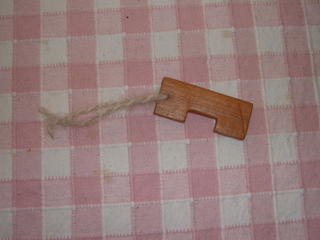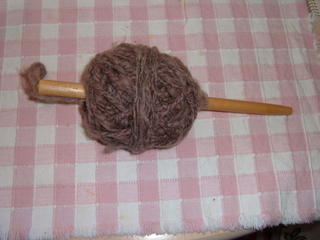
(clockwise from top left: food coloring, food coloring and turmeric, black tea and coffee, marigolds)
But I have also been inspired to make for myself a few of the little tools I've been missing. Now, I could have bought both of these at the yarn store, but I am both poor and

and a nostepinne:

Ok, yes, I used a little creative liscence on the nostepinne: it's really just a tapered dowel that I found in the junk pile of the barn, cut to 10", and sanded (plus the notch in the end). I've never seen one in real life, but I think mine is a lot bigger than nostepinnes usually are--I wrapped some singles off on it, but made more of a center-pull tube than a center-pull ball. It was like plying from a catepillar. Worked well on the chunky handspun you see in the picture though.
The WPI (wraps per inch) gauge is more interesting. I've been wanting one ever since I watched a Mabel Ross video that explained how to actually use it. I also got the wood for this from barn scraps, but it took me a lot longer to actually come up with something I liked. I only have handtools, no power (except a drill): a hacksaw, a pocket knife, and sandpaper. I made about four prototypes of the gauge before I settled on the one above. The first wood I used was too soft and kept flaking. The second was a little better, but also would split when carved. The third I used a piece of leftover moulding, which was easy to carve, but was too big around to be effective for thin yarn--took way too much yardage to get enough wraps. The fourth time I fixed the wood problem, with the reddish-hardwood I ended up with, but I initially tried to put the cut-out along the cut edge of the wood, perpendicular to the grain. Impossible. Then, kind of frustrated, I whipped out the hacksaw and sliced a 3x2 inch piece out of the original 2x4, then cut that in half, ending with a 1x3x2 inch piece of wood. After that it was kind of a breeze to carve out the middle inch and whittle and sand the piece square (or, rectangular). I used a 11/64" drill bit for the hole, finished it up with a couple of coats of Johnson's paste wax (the finish I use for all my wood spinning supplies), and a length of handspun (dog hair from my German Shepherd). Ta-da!
I'm really happy with the way it turned out. It's not 100% even, but I kind-of like that it has a rustic quality. Like they say on Antiques Roadshow: you can see the tool-marks, proves it's original. Also, I feel super crafty. Being a knitter and handspinner I should totally be blase about making stuff, but every time I'm surprised by how wonderful it is to make things with one's own hands.
No comments:
Post a Comment